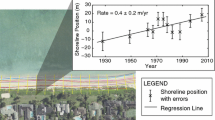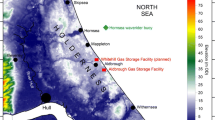Abstract
We present a morphodynamic study of an apparently homogeneous rectilinear coast in SW Spain. The study area covers 14 km of mesotidal sandy beaches, interrupted in some places by rocky-shore platforms. The method used consisted of a monthly monitoring of 12 beach profiles during two years. According to the results obtained from the study, which also include granulometric analyses andin situ determination of the beach disturbance depth, three main beach classes have been differentiated: low-reflective beaches, dissipative beaches and rocky-shore platform beaches. Their longitudinal distribution is not linked to their distance to the main source of sediments in the area (mouth of the river Guadalquivir). Instead, a very irregular long-shore variation of morphodynamic beach states appears. It is deduced that this long-shore variation is mainly linked to local contouring conditions (e.g. the presence of rocky shoals which affect wave-breaking processes), and not to the regional long-shore currents prevailing in the zone.
Similar content being viewed by others
References
Anfuso, G. 2002.Morfología y dinámica sedimentaria del litoral gaditano entre Chipiona y Rota. Doctoral Thesis (ISBN 84-7786-730-5), University of Cádiz, ES.
Anfuso, G., Gracia, F.J., Andrés, J., Sánchez, F., Del Río L. & Lopez-Aguayo, F. 2000. Depth of disturbance in mesotidal beaches during a single tidal cycle.J. Coast. Res. 16: 446–457.
Anfuso, G., Benavente, J. & Gracia, F.J. 2001. Morphodynamic response of nourished beaches in SW Spain.J. Coast. Conserv. 7: 71–80.
Bascom, W.N. 1951. The relationship between sand size and beach face slope.Trans. Am. Geophys. Union 32: 866–874.
Battjes, J.A. 1974. Surf similarity. In:Proceedings of the 14th International Conference on Coastal Engineering ASCE, pp. 466–480.
Benavente, J., Gracia, F.J. & López-Aguayo, F. 2000. Empirical model of morphodynamic beachface behaviour for low-energy mesotidal environments.Mar. Geol. 167: 375–390.
Carter, R.W.G. 1988.Coastal environments. Academic Press, London, UK.
Davis, R.A., Jr. & Hayes, M.O. 1984. What is a wave-dominated coast?Mar. Geol. 60: 313–329.
Dean, R.D. 1973. Heuristic models of sand transport in the surf zone.Proceedings of the engineering dynamics in the surf zone, pp. 208–214. Proceedings of 1st Australian conference of Coastal Engineering. Sydney, AU.
Folk, R.L. & Ward, W.C. 1957. Brazos River Bar: A study in the significance of grain size parameters.J. Sed. Petrol. 27: 3–26.
Fredsoe, J. & Deigaard, R. 1992Mechanics of coastal sediment transport. Advanced series in Ocean Engineering, Vol. 3. World Scientific Publishers.
Gourlay, M.R. 1968.Beach and dune erosion tests. Delft Hydraulics Laboratory, Report M935/M936, Delft, NL.
Guza, R.T. & Inman, D.L. 1975. Edge waves and beach cusps.J. Geophys. Res. 80: 2997–3012.
Jackson, N.L. & Nordstrom, K.F. 1993. Depth of activation of sediment by plunging breakers on a steep sand beach.Mar. Geol. 115: 143–151.
Komar, P.D. & Gaughan M.K. 1972. Airy wave theory and breaker height prediction. In:Proceedings of the 13th International Conference on Coastal Engineering ASCE, pp. 405–418.
Masselink, G. & Short, A.D. 1993. The effect of tide range on beach morphodynamics and morphology: a conceptual beach model.J. Coast. Res. 9: 785–800.
Muñoz, J.J. & Enríquez, J. 1998. Dinámica litoral de una unidad fisiográfica completa: Sanlúcar-Rota.Rev. Obras Públ. Madrid 3375: 35–44.
Muñoz, J.J. & Gutiérrez, J.M. 1999. Tipología y eficacia de los espigones de escollera construidos para la mejora de la estabilidad de las playas del litoral atlántico de la provincia de Cádiz.Bol. Geol. Minero (ITGE, Madrid) 110–1: 53–66.
Nordstrom, K.F. & Jackson, N.L. 1992. Two-dimensional change on sandy beaches in meso-tidal estuaries.Z. Geomorphol. 36:465–478.
Reyes, J.L., Martins, J.T., Benavente, J., Ferreira, O., Gracia, F.J., Alveirinho-Dias, J.M. & López-Aguayo, F. 1999. Gulf of Cadiz beaches: a comparative response to storm events.Bol. Inst. Esp. Oceanogr. (Madrid) 15 (1–4): 221–228.
Shepard, F.P. 1950. Beach cycles in southern California.U.S. Army Corps of Engineers, Beach Erosion Board Technical Memorandum 20, LaJolla, CA, US.
Williams, A.T. 1971. An analysis of some factors involved in the depth of disturbance of beach sand by waves.Mar. Geol. 11: 145–158.
Wright, L.D., Short, A.D. & Green, M.O. 1985. Short term changes in the morphodynamic states of beaches and surf zones: an empirical predictive model.Mar. Geol. 62: 339–364.
Author information
Authors and Affiliations
Corresponding author
Rights and permissions
About this article
Cite this article
Anfuso, G., Martínez del Pozo, J.A., Gracia, F.J. et al. Long-shore distribution of morphodynamic beach states along an apparently homogeneous coast in SW Spain. J Coast Conserv 9, 49–56 (2003). https://doi.org/10.1652/1400-0350(2003)009[0049:LDOMBS]2.0.CO;2
Received:
Revised:
Accepted:
Published:
Issue Date:
DOI: https://doi.org/10.1652/1400-0350(2003)009[0049:LDOMBS]2.0.CO;2




